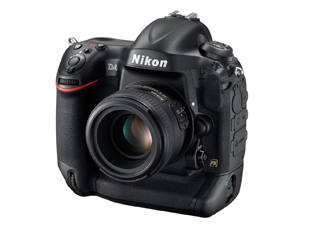Nikon D4
Nikon India recently launched their new flagship camera, the D4 in India. The latest entrant in the professional DSLR camera market, the D4 employs a newly developed Nikon FX format CMOS sensor with 16.2 million effective pixels and boasts of improved video capabilities and a compelling set of features compared to the existing models. Having turned to its professional user base to work out some of the improvements and changes, the new D4 features a few big changes and a host of small improvements compared to its predecessor apart from the more obvious increased megapixel and expanded ISO range.
Look Body and Feel
One look at the camera gives you a hint of what you could expect from this beast! Quite like the D3, the D4 is built tough and seems like it can handle a fair amount of abuse. There’s little change in terms of shape when compared to the D3 or the D3s. The D4 provides better control in both landscape and portrait orientations, making the overall feel a lot more comfortable to use. Some of the controls have been repositioned so as to provide faster access to the front dial and shutter release, making it more comfortable. The control and ergonomics are different with respect to both the D3 and the D3s. Both the joystick and the autofocus control are now easier to access when holding the camera vertically in the portrait orientation. These changes seem to have been made keeping in mind photojournalists and sports photographers making the camera faster and easier to use.

The addition of a record button to the top panel is just one of the changes made to the controls. You’d think the record button would start video recording just by clicking it but it doesn’t quite work that way. You still have to switch live view on first, a button for which is present on the rear panel of the camera, just below the 3.2” LCD. The record button is customisable. The button for switching through metering modes has replaced the command lock button, which has been done away with, just like the AE-L/AF-L button so as to better support using the camera in its vertical orientation. The protect button now also works as picture control when shooting. The rubberised lump on the rear panel below the microphone gives users better grip while using the camera in its vertical orientation. Backlit buttons are a welcome addition and hugely improve camera usability in low light scenarios.

Features
With the increasing demand for video footage from professional photographers, and with stiff competition in this realm, the improvements in terms of video capabilities don’t come as a surprise. Being able to see the audio levels on the rear display while recording video, a headphone jack for audio monitoring, improved audio fidelity are some of the small aspects that Nikon has taken care of with their latest offering.
The newly developed higher resolution 16.2 MP full-frame CMOS sensor enables better low light photography thanks to an ISO sensitivity range from 100 to 12800 at normal settings, and expandable from ISO 50 to ISO 204800 equivalent.
The new 91000 pixel RGB sensor manages to achieve better autofocus, enabling the system to recognise human faces even while shooting with the optical viewfinder. It also plays a significant role in subject tracking, white balance and Active D-Lighting.

The D4 has dual memory card slots – one Compact Flash and one XQD slot, Sony’s new memory card. While the new format might help improve speed, one concern is that it eliminates the possibility of using old CF cards as a second card for backup, and might also mean extra expenditure if you’re interested in purchasing the new card.
The D4 now allows users to vary Auto-ISO based on focal length, which is a welcome development, as earlier it lacked the ability to vary the shutter threshold based on focal length.
Conclusion
The launch of the Nikon D4 was highly anticipated, especially in the wake of the launch of Canon’s EOS-1D X. Featuring a few big changes and a host of small improvements in comparison with its predecessor, the Nikon D4 more than exceeded our expectations with its performance in the mid ISO range. However, its performance at ISO 12800 and beyond did leave a lot to be desired. The improvements in the camera’s video capabilities are also significant. However, at a price of Rs. 324,950, the D4 isn’t exactly cheap, and only time will tell how this model will fare in today’s competitive market.
Too read the whole review and the performance and ratings, grab the April 2012 issue of the magazine today.
Text: George Kurien and Ajay Singh

